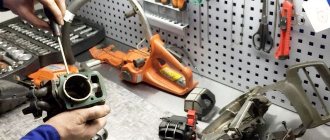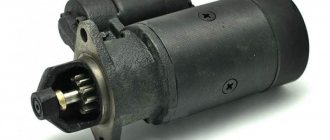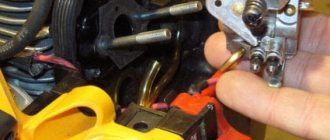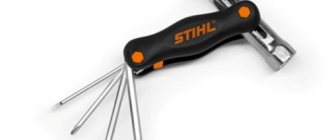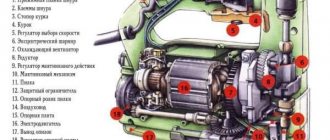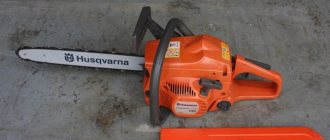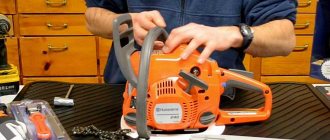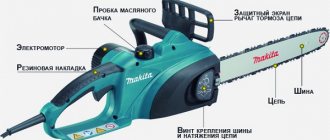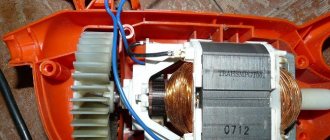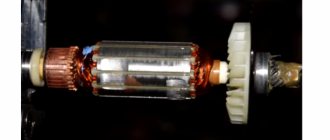Most well-known manufacturers of chainsaws equip their products with starters that work on almost the same principle. Its essence is as follows: in the groove of the saw body there is a handle through which the cord is passed. When the handle is raised sharply, the cord is also pulled out, which engages the drum, which is located in the ratchet mechanism. Through this, a drum with spokes, which is located on the shaft, is activated. During this, the crankshaft makes a couple of revolutions, which leads to compression of the fuel mixture, which at this moment is between the cylinder head and the piston. When the handle is lowered, on the contrary, the ratchet and the pins lose their contact, which leads to the shaft stopping. As the power of the chainsaw increases, the amount of fuel mixture increases, which must ignite when the chainsaw is started. In this case, to start the engine, it is necessary to increase the number of pulls on the starter cord. To speed up the return of the drum mechanism, manufacturers use a special steel starter return spring, which has excellent elasticity. To make starting a chainsaw easier, leading brands also use other methods:
- Preliminary enrichment of the fuel mixture using a separate damper;
- Installation of an automatic decompression valve, which reduces the pressure inside the chainsaw cylinder;
- Installing a primer designed to pump fuel before starting the engine.
The use of one of these technologies significantly facilitates starting and extends the service life of the starter, which is especially noticeable at low temperatures.
- How to Start a Stihl 180 Chainsaw
- How to Cut a Countertop at Home
- How to Clean the Carburetor of a Stihl 180 Chainsaw
- Which Circular Saw is Best for the Home
- Adjusting the Carburetor of a Stihl 250 Chainsaw with Your Own Hands
How to fix the starter spring on a generator and chainsaw
Almost all modern starting devices recommend installing a spring to start the generator in case of battery failure. How to sharpen a chain on a chainsaw for a beginner? Sharpening a chainsaw chain on a machine. Starter for chainsaw. How to install a spring on a chainsaw starter? Place the spring. How to assemble a starter on a chainsaw. Over time, the device may fail, then you need to know how to repair the starter spring on the generator on your own.
Why do you need a manual starter?
ATTENTION! A very simple method has been found to reduce fuel consumption! Don't believe me? An auto mechanic with 15 years of experience also didn’t believe it until he tried it. And now he saves 35,000 rubles a year on gasoline! Read more"
An electric starter is provided as the main starter. But we should not forget that if the battery is faulty, starting the vehicle using an electronic starter will not be possible. This is how we repaired the chainsaw starter, remove the spring, how to correctly reference. For this case, a manual option was provided as a backup option.
A striking example of the use of a recoil starter is portable power plants. How to make a starter on a chainsaw yourself? How to bend the spring on a chainsaw starter? How to wind a spring and how to wind a chainsaw starter rope. Everything, as usual, is simple and easy, and most importantly. Fishing line. Therefore, it is important to know how to choose and wind it correctly on a reel. starter on them , because it makes it possible to comfortably start the engine and operate the generator.
Recoil starter spring fault
The sealed starter spring with hook is the main design element of the manual starter. How to repair a chainsaw starter, wind the cord on how to draw on. How to install a spring on a chainsaw starter? Place the starter spring in the desired groove. In addition to the spring, the starter also includes the following components:
- Ratchet;
- Cord with reel;
- Screw for fixation;
- Return spring;
- Plastic ratchet fuselage.
Repairing a spring, the main component of a manual starter, comes down to replacing the element.
Ah, this is how the substitution is carried out:
Chainsaw starter repair. With my own hands.
How to make your own starter
on
a chainsaw
?
How to bend the spring
on a chainsaw starter?
How to wind a spring
How to wind a starter spring on a power tool
This is how I wind the starter springs
gas trimers, but
the springs of starters
of saws and walk-behind tractors are wound along
- Use a screwdriver to unscrew the pulley screw;
- Then the spring itself is removed.
On chainsaws, for example, it is an element in the form of a circle, inside of which a flexible spring is wound.
Springs are sold in this form in hardware stores. How to wind the starter spring of a power tool. All that remains is to buy the part and replace it.
Repairing a recoil starter may also involve replacing the cord. How to wind a spring and how to wind a starter rope, how to repair a chainsaw starter. If it is incorrectly wound on the spring pulley, the generator will not start.
Here are some rules for winding cord:
- Wind the cord from the end of the pulley (this is done to avoid twisting);
- The second end of the cord is inserted into the hole in the cover;
- Winding the cord should continue until it stops, that is, as long as the length of the rope is sufficient;
- After winding, the cord is pulled out 15-20 cm to check the rotation of the spring pulley;
- After winding, you should also check how the spring after pulling and releasing (if everything works well, it is recommended to wind the cord one more turn).
How to assemble a starter on a chainsaw?
After replacing the faulty elements of the starter, it is time to reassemble it. In this case, maximum accuracy must be observed, since the slightest discrepancy can lead to breakdown of the trigger mechanism. Assembly of the unit must be performed in the following sequence:
- The standard cable will need to be threaded into the factory hole of the reel. There is no need to wind the cord;
- Next, you will need to insert the coil into its base location. At this stage, many beginners make a common mistake. There are 2 slots on the surface of the coil. The standard coil spring hook should fit into one of them. To do this, the coil will need to be installed in such a way that it fits tightly into its original place, and the existing hook fits exactly into the slot. Correct installation must be checked by turning the coil clockwise until resistance appears;
- Then you need to install a device for easy starting of the chainsaw. In this case, the protrusion of the latter should be located in the recess of the installed coil;
- After this, you will need a screw and washer to secure the device;
- Next, the second end of the cord must be tucked into a special outlet hole;
- The next step is to thread the cable into the starting handle. For this purpose, you will need to tie a medium-sized knot at the end of the cord. If it is too small, the cable will slip, causing it to quickly wrap around the trigger drum;
- Then you will need to release the loop inside the starter. Immediately after this, you should begin to rotate the trigger mechanism in the direction of the clock hand. There is no need to wind the cord. Next, you will need to fix the reel with your hand and pull the loop outward by the handle;
- After this, you need to check the operation of the trigger mechanism;
- If the unit is working properly, all that remains is to install it on the tool and secure it with three screws.
Repairing a starter is not a difficult procedure if you follow the correct procedure. Typically, replacing the starter cord will take no more than 20 minutes. The main thing is to correctly position the pulley and drum in relation to each other. Otherwise, the trigger will not work.
How to hold a chainsaw
To properly start a chainsaw, an important point is how the saw is positioned at this moment, or more precisely, how the operator holds it. There are two options for correctly holding the saw at the moment of starting.
The first option: the saw is installed on a flat surface, the operator’s left hand is straight and holds the saw by the upper handle, the right foot is installed on the right hand guard and presses the saw to the ground.
In this position, it is as convenient as possible for the operator to launch the tool, since the right hand is free and the tool is securely fixed.
Before starting the saw, regardless of the position in which it will be carried out, it is necessary to turn on the saw chain brake.
Option two: The operator stands, his left hand holds the top handle of the saw, while the operator holds the rear handle between his legs.
This position allows you to easily start a low-power saw, and at the same time securely fix it, preventing yourself from accidents.
Before starting the chainsaw, make sure that there are no people or animals in the immediate vicinity.
You can watch the video on how to start a chainsaw and visually study the startup steps below. In the video, a specialist from the Shtil company talks about how to properly operate the tool and start it using the example of the Stihl MS 211 chainsaw. The video is very informative and contains reliable information from the manufacturer.
Recoil starter spring fault
The tight starter spring with hook is the main design element of the manual starter. In addition to the spring, the starter also includes the following components:
- Ratchet;
- Cord with reel;
- Screw for fixation;
- Return spring;
- Plastic ratchet fuselage.
Repairing a spring, the main component of a manual starter, comes down to replacing the element.
Here's how the replacement is done:
- Use a screwdriver to unscrew the pulley screw;
- Then the spring itself is removed.
On chainsaws, for example, it is an element in the form of a circle, inside of which a flexible spring is wound.
Springs are sold in this form in hardware stores. All that remains is to buy the part and replace it.
Repairing a recoil starter may also involve replacing the cord. If it is incorrectly wound on the spring pulley, the generator will not start.
Here are some rules for winding cord:
- Wind the cord from the end of the pulley (this is done to avoid twisting);
- The second end of the cord is inserted into the hole in the cover;
- Winding the cord should continue until it stops, that is, as long as the length of the rope is sufficient;
- After winding, the cord is pulled out 15-20 cm to check the rotation of the spring pulley;
- After winding, you should also check how the spring works after pulling and releasing (if everything works well, it is recommended to wind the cord one more turn).
On portable power stations, spring and cord repairs are carried out as follows:
- On the side of the generator there is a pulley circle, fixed with three screws that must be unscrewed;
- Remove the pulley with the spring and the cord;
- Check the condition of the cord, which can be completely removed from the side of the holder (the upper cap of the holder is removable).
Note. Often the knot of the cord that secures it from above becomes loose. To correct the situation, you need to heat the end of the nylon rope with a lighter, and then wind a new knot.
As for the pulley with the spring, it is changed in the same way as described above.
Starter repair Husqvarna and Shtil - subtleties and features of the work
To repair a starter on a Shtil 180 saw, you need to carry out the following step-by-step steps:
- Unscrew the outer cover with a screwdriver or a special screwdriver.
- We disassemble the components of the chain saw starter, namely the bushing, starting spring, cover, handle, cord, coil, deflector.
- We examine each of them for the absence of cracks, defects, changes in color and structure.
- Often the cord is broken or wound outside the starter coil. You need to wind it into place yourself, spin it several times to start it, or order a new one in our store. It happens that it breaks off at the point of attachment to the handle or trigger coil.
- A damaged pulley is a cracked, chipped or warped part that cannot function properly. We purchase a new one and replace it in place of the old one.
- In most cases, the starting spring bursts, unable to withstand the load. Defects at the place of its attachment, insertion site and other problems are also very common.
Upon completion of the system repair, you need to reassemble it in the correct order. Namely, the pulley is located above the starting spring, firmly engaging with it; it is wrapped with a cord, the edge of which is threaded into the lid so that at the moment of start the pulley winds the cable inward. The required voltage can be achieved by making four turns. You can find out all the details of the procedure for yourself in a detailed video.
Repairing a Husqvarna starter is almost no different from similar operations performed with a Shtil starter, but an important nuance here is ensuring that the parts match the chainsaw itself. That is, if you try a reel from a completely different saw, this may lead to unpleasant consequences in your work. It’s another matter if the store recommends a cheap analogue with which your saw will work for a long period. It is worth noting that for Husqvarna 142 or Shtil 180, as the most popular consumer saws, you should not use homemade elements, for example, a cord or other devices. The starter spring is one of the most frequently replaced parts. This is partly due to the fault of the operator if he regularly exerts excessive force to start the saw, and sometimes due to the unreliability of fastening one of the edges of the spring. In the same way, you need to replace parts on a Ural saw, perhaps with a little more physical effort.
Read also: What is the difference between a torch and a cutter?
The design and principle of operation of a chainsaw starter
All types of chainsaws, both Chinese and European, are equipped with starters of identical design and operating principle. The universal design of starters allows these devices to be used both on branded chainsaws and on semi-official tools supplied from the Middle Kingdom. It is only important to note that domestically produced instruments have some distinctive features.
A starter for a chainsaw is a simple mechanism consisting of:
- Drum.
- Rope.
- A handle connected to a cable.
- Frame with return spring.
The operating principle of such a device is also quite simple. When the handle, which is connected by a cable to the drum of the ratcheting mechanism, is pulled, it moves. When moving, the drum engages with the splines of another drum, which is located on the shaft. Thus, the crankshaft of the saw moves manually, which makes several revolutions. As soon as the handle returns to its original position, assisted by the return spring, the spline connection is lost, causing the shaft to stop. With each movement of the crankshaft, the amount of fuel-air mixture in the cylinder increases, which ultimately contributes to its ignition.
Starter breakdowns and how to fix them
If you have to frequently start the chainsaw engine, this entails accelerated production of the starting device. It is impossible to predict which part of the starting device will fail first, but most often the cable breaks or the spring bursts. It is not difficult to determine the malfunction of a broken cable, but in any case, if a breakdown occurs, then inspection and repair of chainsaw starters will be required.
Appearance of the device
Common breakdowns of the starting mechanism of units and their elimination:
- Broken cord and replacing it. As soon as the motor starts, the cable comes into contact with the mechanism body in the form of friction, thereby rubbing it. If the cable has obvious signs of wear, then it is better not to wait until the handle comes off completely, and you will be able to start the chainsaw only after repair. The launch rope needs to be replaced, for which the housing is disassembled and the ratchet mechanism is raised. It should be lifted carefully to prevent the return spring from jumping off. The old cable is disconnected and a new starter cable is installed in its place. After replacement, the cover is replaced
- Replacing starter springs for chainsaws. Now let's look at how to replace the starting spring of a gasoline unit - this is a device that returns the drum along with the cable to its original position. If the spring is damaged at the point of connection to the drum (where the loop is formed), then it is not at all necessary to replace it with a new one. To do this, you can make a new loop, having previously cleaned the damaged area. After this, the spring is heated to a temperature of 600-650 degrees (when it turns crimson) and gradually cools. At a temperature of 150 degrees, make a bend and cool the part completely. Now you can install it in place and continue operation. If heating difficulties occur or the spring breaks elsewhere, then it should be replaced
- Repairing and replacing flywheel pawls with your own hands is not particularly difficult. Work begins with dismantling the flywheel and removing the pawls. In place of the removed pawls, new ones made of the same materials should be installed. If instead of plastic you decide to use metal, then they may last longer, but the flywheel will wear out faster. How to replace the chainsaw flywheel pawls is described in detail in the video.
Read also: Direction of teeth on a hacksaw for metal
How to repair a starter on a chainsaw
The cause of a malfunction of the chainsaw starting system may be:
- Drive pulley. This part is subject to high axial and radial loads, so before starting work it is recommended to inspect the pulley for damage and cracks on the back of the housing. If necessary, repair the part or replace it with a new one.
- Spring mechanism. If it has lost its properties or has cracks or breaks, this element must be replaced. It is also recommended to inspect the mounting points for defects.
- Launch system rope. The rope should be inspected for wear and damage. If necessary, replace the part and install it on the pulley.
Diagnostics
Diagnostics of the tool launch system is carried out as follows:
- Unscrew the mounting screws and remove the cover.
- Unscrew the screw that secures the mechanism to the protective cover.
- Start the starter smoothly by removing the spring and clamps from it.
- To inspect for wear and defects, dismantle the cable reel.
- Check the fuel system for the presence of water in it. If there is water inside the system, the fuel fluid must be replaced.
- Inspect the power unit for overfilling with fuel fluid. In this case, you need to unscrew and dry the spark plug, pull the starter, removing the air damper.
- Check the spark plug for a spark.
Reviews about the model PCB-14/37L
If you liked the Interskol chainsaw described above, it is recommended that you read the owner’s reviews about it before purchasing the product. From them you can find out that consumers like automatic chain lubrication and the presence of an easy starting system. This is expressed in a starter with an additional spring. Buyers like that the equipment has a vibration damping system, as well as electronic ignition. At idle, the equipment will turn off, because it has an adjustable oil pump.
Chainsaw starter device
Starters for most chainsaws have the same design. It is because of this that some stores offer customers universal triggers that are suitable for installation on models from Stihl, Husqvarna, and Partner. However, the starters of domestic chainsaws Ural or Lesnik have some differences from the majority.
As standard, the chainsaw starter consists of a number of parts.
These include:
- coil;
- cable;
- frame to which the return spring is attached;
- pen.
A protective cover is installed over all starter elements. The initial operating principle of most trigger mechanisms is also almost the same. In a special groove in the chainsaw body there is a handle that holds the cable. When the handle is raised sharply, the latter is understood. At this moment, the ratchet is activated, which transmits the force through the drum to another splined drum located on the motor shaft.
When the standard cable is pulled, the chainsaw motor shaft begins to rotate, which leads to compression of the existing fuel mixture, located at this time between the cylinder head and the standard piston.
As the cylinder volume of an internal combustion engine increases, the amount of consumed fuel mixture, which is required for its future ignition, simultaneously increases. Accordingly, the operator of a powerful saw needs to make more jerks than the owner of a household tool with low power. To increase the speed at which the drum returns to its original position, manufacturers of powerful chainsaws use elastic return springs.
